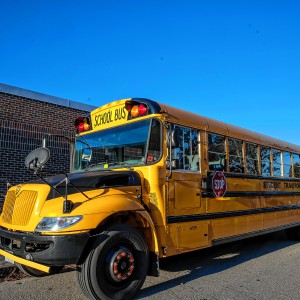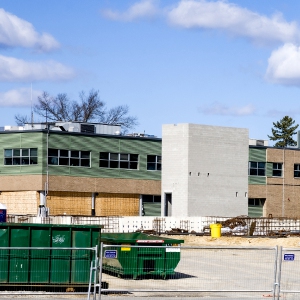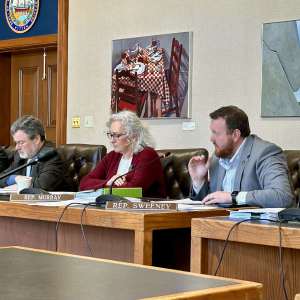Rethinking Rundlett: Monitor poll finds residents divided on middle school location reversal, but strongly supportive of charter amendments
|
Published: 10-22-2024 3:12 PM
Modified: 10-23-2024 5:22 PM |
An overwhelming majority of Concord residents support stripping the Concord School Board of some of its power, yet residents are split on whether the decision to build a new middle school about six miles away from the current location should be reversed, a Monitor poll found.
Seventy-four percent of residents said the school board should be required to get voter approval for all school building moves or property sales. Currently, the autonomous school district can make those decisions unilaterally, but a pair of charter amendments on the November ballot would change that. The support expressed in the Monitor poll surpasses the 60% threshold required for the amendments’ passage.
“I know some of the people on the school board. I know they’re elected, but they still have to answer to the public,” said Steve Sawyer, 67, a poll respondent from Ward 10 who supports the charter amendments. “I’m in real estate and do a lot of construction, and line-by-line they show where the money’s going. If they could do that here, then I think people would have a better feeling on building the new school.”
While some have framed the amendments as a referendum on the school board’s controversial decision last December to relocate the middle school to 24 acres of raw land near the Broken Ground and Mill Brook schools, residents are split on whether the decision should be reversed now, with about 35% saying they are in favor going back, 31% who support the decision and 34% who said they weren’t sure.
Of the 31% who say they support moving the middle school to the city’s east side, 21% agreed with the initial decision, while 10% disagreed or were undecided on it but don’t want to see it reversed now.
Clara Dietel, 43, a mother of two from Ward 5, didn’t have a strong opinion on the initial decision but doesn’t want to see it flipped now.
“I feel the decision’s been made,” Dietel said. “At this point, I don’t think either of my kids will be able to benefit, but I’d just rather see it get built.”
The Monitor’s poll results are based on the answers of 100 residents to a 15-question poll administered from Oct. 1 to 10. Streets in every city ward – except Ward 1, which is primarily in the Merrimack Valley School District – were randomly selected and reporters went door-to-door. In all, residents residing on 36 different streets were polled. (More information about the methodology of the poll is below.)
Article continues after...
Yesterday's Most Read Articles
 House committee defunds relief program for mothers and children, spares SNAP incentives
House committee defunds relief program for mothers and children, spares SNAP incentives
 No high-speed E-ZPass at Hooksett tolls for at least two months
No high-speed E-ZPass at Hooksett tolls for at least two months
 New Hampshire law enforcement to step up traffic enforcement on Route 106
New Hampshire law enforcement to step up traffic enforcement on Route 106
 Schools in Lakes Region explore creating a special education school to bring down costs
Schools in Lakes Region explore creating a special education school to bring down costs
 Work continues on new state psychiatric hospital in Concord
Work continues on new state psychiatric hospital in Concord
 House committee reverses vote, adopts prohibition on DEI activities and spending
House committee reverses vote, adopts prohibition on DEI activities and spending
The results show that 44% of residents believe the Concord school district erred when it selected Broken Ground for the site of its next middle school. Of those who had made up their minds, twice as many residents opposed the initial decision as supported it – but due to the number of people who were still undecided, it was short of a majority of those surveyed.
While a vocal group of residents have protested the decision made late last year to build the district’s new middle school on the city’s east side rather than next to its current location in the city’s south end, it’s far from a small minority.
Importantly, while the amendments were motivated by frustration over the middle school location decision, it remains unclear whether their passage would trigger a vote on the location of the project itself. The language of the first question requires a district-wide vote when a school is “relocated.”
School board members have argued that since the vote to relocate the middle school was taken last December, the amendment would not apply retroactively to the middle school even though the design and bond for the project have not been approved. That assertion could end up being challenged in court if the amendments pass.
The actual question on the ballot reads, “No Concord public school existing as of January 1, 2024, including but not limited to the district’s middle school, (Rundlett Middle School), shall be relocated from the parcel on which it was situated as of January 1, 2024, to be rebuilt or replaced elsewhere, without an affirmative simple majority vote of Concord School District voters voting on the question ratifying such relocation.”
Respondents’ family status, age, and household income – factors that are interrelated – all affected sentiment on the initial decision to relocate the middle school.
■A higher percentage of people without children (48% opposed) currently attending Concord schools were opposed to the initial decision than people with children (33% opposed). Those with children in fourth grade or lower – the students who would attend the new middle school under the current timeline – were in fact slightly more opposed to the decision than those who had children in the older grades exclusively.
■Residents who were 65 or older were nearly twice as likely to oppose the initial decision (57% oppoisition) as residents who were between 18 and 34 (33% opposition).
■Residents with a household income below the median in Concord of $80,000 were 12 percentage points more likely to oppose the initial location decision (51% opposition) than residents with a household income above the median (39% opposition).
Opposition to the initial decision varied by ward – though sample sizes for ward-level data are quite small with the Monitor surveying between 8 and 16 people per ward.
■Ward 7, which includes Rundlett, was the most strongly opposed (64% opposition) of the nine wards in which the poll was conducted.
■Ward 10, which is one of Concord’s largest geographic voting areas but also includes Broken Ground, was evenly split (38% opposition and support; 25% undecided).
■Ward 3 was the only ward in which supporters of the initial decision outnumbered opponents (45% support versus 9% opposition).
Generally, the survey found that opinions on the charter amendments were tied to opinions on the initial decision.
■Those who opposed the initial decision overwhelmingly supported the charter amendments (93% support), while those who supported or were undecided on the initial location were about evenly split on the charter amendments (52% support).
■People without children in the district were more likely to support the charter amendments (79% support) than people with children currently or expected to be in the school district (59% support).
The charter amendment ballot questions may not necessarily be the referendums on the middle school location some are making them out to be.
■While three-quarters of respondents support passage of the charter amendments, only 35% support reversing the middle school location decision now.
■Put another way, 42% of respondents both support the amendments and either oppose or have no opinion on reversing the middle school location decision.
Respondents were asked how important the following four factors of the middle school project were to them: the cost, the location, the environmental impact, and the duration of construction.
■Overall, the environmental impact and cost were most important (3.77 and 3.73 on a 1 to 5 scale, respectively), while the duration was the least important (2.81).
■Surprisingly, the duration was the least important factor even for families of children who would attend the new school under the current timeline. Moreover, it was not any more important to them than to respondents at-large.
In consultation with the UNH Survey Center, the Monitor devised its methodology and decided an in-person survey was the best choice instead of other methods, like a phone poll or mailed questionnaire.
Street names were randomized within each ward (exclusive of Ward 1, which was omitted from the poll because it is primarily in the Merrimack Valley School District). Starting at the top of the randomized list, reporters then went door-to-door, moving to the next street once they had received five responses or they had reached the street’s end. Streets that were very rural or were primarily commercial were generally skipped.
Reporters explained to those who answered their doors that they were conducting an anonymous poll about the middle school project on behalf of the Monitor. (Though the responses to the poll were anonymous, respondents were asked at the end of the poll whether they would be willing to be contacted by a reporter in the future to share their views publicly.)
Even if respondents were not aware the school district was in the process of building a new middle school (16% of respondents), the reporter still proceeded with the poll. The reporter asked the questions verbally, filling out the answers on a Google form.
The goal was to get 11 responses in each ward, though some wards proved easier than others. Between 8 and 16 responses were collected in each ward, for a total of 100 responses. Weighting responses based off ward-level participation in the most recent election did not dramatically skew results.
This method presented a number of limitations. First, while it incorporates randomness, it is not totally random because certain streets were deemed inaccessible and thus skipped. The survey was generally conducted between 4 p.m. and 7 p.m. on weeknights, which excludes those who are not home during that time period. Apartment buildings were also more likely to be inaccessible than one-family homes. Lastly, the Monitor was unable to administer the survey in languages other than English.
Though the survey samples were collected fairly uniformly, wards are not evenly represented in elections. In 2023, for example, 20% of votes in the school board election came from Ward 5, while 5% came from Ward 2. When analyzing the data, the Monitor considered weighting responses according to participation in the 2023 election but found that doing so did not significantly alter results. As a result, the results reported are unweighted.
Responses to the Monitor’s poll were collected by Geoff Forester, Sruthi Gopalakrishnan, Jeremy Margolis, Charlotte Matherly, Catherine McLaughlin, Alexander Rapp, Michaela Towfighi, Jonathan Van Fleet and Rachel Wachman. The poll design and analysis was completed by Jeremy Margolis.











 Henniker ponders what is a ‘need’ and what is a ‘want’
Henniker ponders what is a ‘need’ and what is a ‘want’ Boscawen residents vote to fund major renovation of public works building
Boscawen residents vote to fund major renovation of public works building ‘Voting our wallets’: Loudon residents vote overwhelmingly against $1.7M bond for new fire truck
‘Voting our wallets’: Loudon residents vote overwhelmingly against $1.7M bond for new fire truck In Pembroke, Education Freedom Accounts draw debate, voters pass budget
In Pembroke, Education Freedom Accounts draw debate, voters pass budget
